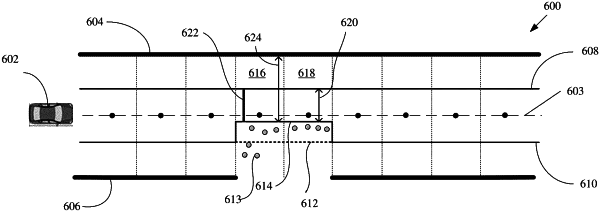| CPC B60W 30/0953 (2013.01) [B60W 30/09 (2013.01); B60W 30/18163 (2013.01); G05D 1/0214 (2013.01); G05D 1/0223 (2013.01); B60W 2552/53 (2020.02); B60W 2554/4041 (2020.02)] | 21 Claims |

|
1. A method for proactively mitigating risk to a vehicle traversing a vehicle transportation network, the method comprising:
determining a first hazard zone for a first hazard object ahead of the vehicle in a direction of travel of the vehicle, wherein the vehicle is traversing a lane within the vehicle transportation network, the lane is defined by a left lane boundary and a right lane boundary extending in a longitudinal direction relative to the direction of travel, and the first hazard zone includes a first target lateral constraint that extends over the left lane boundary and into the lane such that the vehicle may avoid the first hazard object without a speed constraint;
determining a second hazard zone for a second hazard object ahead of the vehicle in the direction of travel, wherein the second hazard zone includes a second target lateral constraint that extends over the right lane boundary and into the lane such that the vehicle may avoid the second hazard object without a speed constraint;
allocating, for each discretized time and location where the first hazard zone and the second hazard zone overlap in the longitudinal direction, a lateral buffer defined by the lane to a first allocated lateral constraint for the first hazard object and a second allocated lateral constraint for the second hazard object, wherein allocating the lateral buffer comprises:
using the first target lateral constraint and the second target lateral constraint as input; and
minimizing a difference between a lateral constraint ratio for the left lane boundary and a lateral constraint ratio for the right lane boundary;
determining a first longitudinal constraint based on a time of arrival of the vehicle at the first hazard zone;
determining a second longitudinal constraint based on a time of arrival of the vehicle at the second hazard zone;
determining, using the first allocated lateral constraint, the second allocated lateral constraint, the first longitudinal constraint, and the second longitudinal constraint, a proactive trajectory for the vehicle comprising at least one of a lateral contingency or a longitudinal contingency; and
controlling the vehicle according to the proactive trajectory.
|